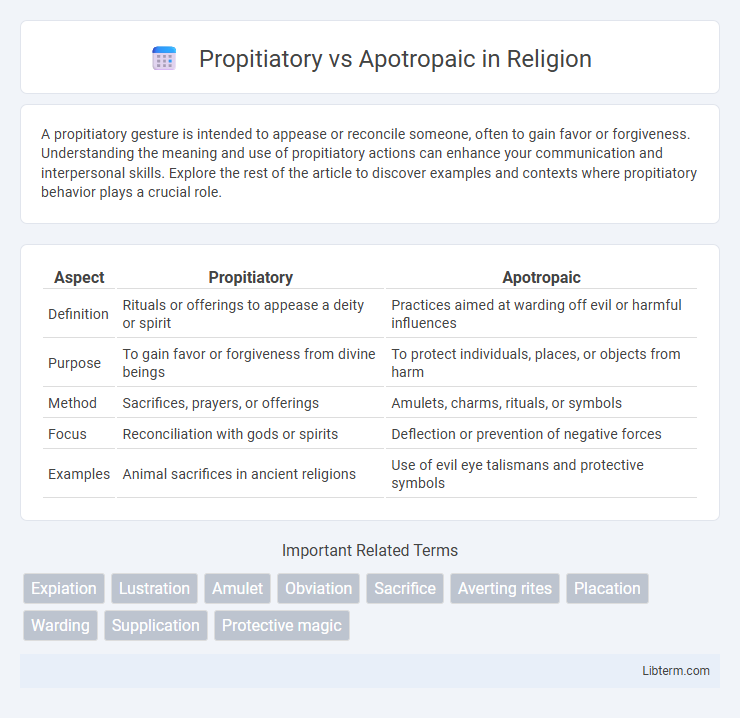A propitiatory gesture is intended to appease or reconcile someone, often to gain favor or forgiveness. Understanding the meaning and use of propitiatory actions can enhance your communication and interpersonal skills. Explore the rest of the article to discover examples and contexts where propitiatory behavior plays a crucial role.
Table of Comparison
| Aspect | Propitiatory | Apotropaic |
|---|---|---|
| Definition | Rituals or offerings to appease a deity or spirit | Practices aimed at warding off evil or harmful influences |
| Purpose | To gain favor or forgiveness from divine beings | To protect individuals, places, or objects from harm |
| Method | Sacrifices, prayers, or offerings | Amulets, charms, rituals, or symbols |
| Focus | Reconciliation with gods or spirits | Deflection or prevention of negative forces |
| Examples | Animal sacrifices in ancient religions | Use of evil eye talismans and protective symbols |
Understanding Propitiatory and Apotropaic: Key Definitions
Propitiatory rituals aim to appease or placate a deity or spirit by offering sacrifices or favors, seeking to gain their goodwill and avoid punishment. Apotropaic practices are designed to ward off evil, harmful influences, or bad luck through protective symbols, actions, or charms. Understanding the distinction between propitiatory and apotropaic methods is crucial for analyzing religious ceremonies and cultural behaviors centered on divine interaction and protection.
Historical Roots of Propitiatory and Apotropaic Practices
Propitiatory practices have historical roots in ancient religious rituals aimed at appeasing gods through offerings and sacrifices to prevent divine wrath, as seen in ancient Mesopotamian and Greco-Roman cultures. Apotropaic customs, originating in early civilizations like ancient Egypt and Greece, involved protective symbols, amulets, and gestures designed to ward off evil influences and harmful spirits. Both practices emerged from humanity's deep-seated desire to influence supernatural forces, with propitiatory acts focusing on placation and apotropaic methods emphasizing protection.
Propitiatory Rituals: Appeasing Deities and Forces
Propitiatory rituals involve offering sacrifices, prayers, or gifts to appease deities and supernatural forces, aiming to gain favor or avert divine wrath. These ceremonies are designed to restore harmony between humans and gods by fulfilling religious obligations or correcting transgressions. Common examples include animal sacrifices, libations, and chanting specific incantations to ensure protection, prosperity, and forgiveness.
Apotropaic Acts: Warding Off Evil and Misfortune
Apotropaic acts involve rituals, symbols, or gestures specifically designed to ward off evil spirits, bad luck, or misfortune, such as hanging protective talismans, performing cleansing ceremonies, or using sacred chants. These practices are rooted in various cultural traditions and are believed to create a spiritual barrier that deflects harmful influences. Unlike propitiatory acts, which aim to appease deities or spirits, apotropaic measures focus solely on prevention and protection from negative forces.
Symbolism in Propitiatory and Apotropaic Traditions
Propitiatory traditions use symbolism to appease or placate deities or spirits, often involving offerings or rituals that seek favor and protection. Apotropaic symbolism serves to ward off evil influences or harmful spirits, employing objects such as amulets, talismans, and protective motifs. Both traditions reflect culturally embedded beliefs about managing supernatural forces through symbolic acts and artifacts.
Cultural Variations: Global Perspectives on Both Approaches
Propitiatory and apotropaic practices reveal diverse cultural approaches to influencing divine forces and warding off evil across societies. In East Asian traditions, propitiatory rituals often involve offerings to appease deities for blessings, while apotropaic symbols such as the Chinese Fu talisman provide protection against misfortune. African cultures exhibit rich variations where propitiatory ceremonies seek favor from ancestral spirits, contrasted with apotropaic charms and amulets used widely to repel malevolent influences and ensure communal harmony.
Propitiatory vs Apotropaic: Core Differences
Propitiatory rituals aim to appease a deity or spirit to gain favor or avert punishment, often involving offerings or sacrifices to satisfy divine demands. Apotropaic practices focus on warding off evil or harmful influences by using protective symbols, charms, or actions designed to repel malevolent forces. The core difference lies in propitiation seeking to mollify a supernatural power, while apotropaic efforts serve to block or deflect negative energies.
Overlapping Practices: When Propitiatory Meets Apotropaic
Propitiatory and apotropaic practices often overlap in rituals aimed at both appeasing deities and warding off evil, blending offerings and protective symbols to ensure divine favor and safeguard practitioners. In many cultures, propitiatory sacrifices coexist with apotropaic charms, reflecting a dual approach to managing spiritual forces through both appeasement and defense. This intersection highlights how rituals serve complex spiritual needs by combining elements that seek to influence gods while repelling malevolent influences.
Modern Interpretations and Applications
Propitiatory practices in modern contexts often involve rituals or symbols intended to appease deities or spirits to gain favor, commonly seen in religious ceremonies and cultural events worldwide. Apotropaic methods, designed to ward off evil or harmful influences, are integrated into architecture, jewelry, and popular superstitions, such as the use of protective talismans or symbols like the evil eye. Both concepts influence contemporary spiritual practices and psychological frameworks, emphasizing protection and harmony in personal and communal spaces.
Choosing Between Propitiatory and Apotropaic Approaches
Choosing between propitiatory and apotropaic approaches hinges on the desired outcome: propitiatory rituals aim to appease deities or spirits by offering sacrifices or gifts to gain favor, while apotropaic practices focus on warding off evil and harmful influences through protective symbols or actions. An effective decision depends on cultural context and the specific challenge, where propitiatory methods mitigate divine displeasure, and apotropaic methods prevent misfortune or malevolent forces from causing harm. Understanding these distinctions aids in selecting rituals or symbols that either establish harmony with supernatural entities or shield individuals and communities from negative energies.
Propitiatory Infographic

 libterm.com
libterm.com